NVIDIA GeForce GTX 670 Review Feat. EVGA: Bringing GK104 Down To $400
by Ryan Smith on May 10, 2012 9:00 AM ESTAs always, we’re wrapping up our look at a video card’s stock performance with a look at power, temperature, and noise. As GTX 670 is a lower clocked, lower power, harvested version of GK104, it should do even better than GTX 680 here. Remember, the power target for GTX 670 is only 141W.
| GeForce GTX 600 Series Voltages | |||||
| Ref GTX 670 Boost Load | EVGA GTX 670SC Boost Load | Ref GTX 680 Boost Load | Ref GTX 670 Idle | ||
| 1.175v | 1.162v | 1.175v | 0.987v | ||
Stopping to take a quick look at voltages, we find that NVIDIA hasn’t really adjusted the voltages of GTX 670 compared to GTX 680. Because GTX 670 has a lower maximum boost bin than GTX 680 it ramps up to 1.175v a bit sooner, but otherwise it’s still covering the same range of voltages as opposed to having a lower max voltage to further improve the power consumption. EVGA however does just that, topping out at 1.162v. They’ll need all the power savings they can get since power consumption is inversely proportional to performance under NVIDIA’s power target system.
On that note before we jump into our graphs we wanted to try something new: a look at the average core clockspeed during our benchmarks. Because of GPU boost the boost clock alone doesn’t give us the whole picture – particularly when also taking a look at factory overclocked cards – we’ve recorded the clockspeed of our GPU during each of our benchmarks when running them at 2560x1600 and computed the average clockspeed over the duration of the benchmark.
| GeForce GTX 670 Average Clockspeeds | ||||
| GTX 670 | EVGA GTX 670SC | |||
| Max Boost Clock | 1084MHz | 1188MHz | ||
| Crysis | 1057MHz | 1079MHz | ||
| Metro | 1042MHz | 1066MHz | ||
| DiRT 3 | 1037MHz | 1062MHz | ||
| Shogun 2 | 1064MHz | 1105MHz | ||
| Batman | 1042MHz | 1075 MHz | ||
| Portal 2 | 988MHz | 1034MHz | ||
| Battlefield 3 | 1055MHz | 1080MHz | ||
| Starcraft II | 1084MHz | 1129MHz | ||
| Skyrim | 1084MHz | 1113MHz | ||
| Civilization V | 1038MHz | 1073MHz | ||
| OCCT | 953MHz | 980MHz | ||
In spite of the GTX 670’s boost clock of only 980MHz, we see that it spends almost its entire time above that, and indeed spends its whole time above the base clock. As far as games go, with the exception of Portal 2 it’s always in the mid-1000s, whereas the GTX 680 was only a bit higher at the high 1000s. This is a big part of why the GTX 670 has performed so well in our tests: it may be rated lower, but in fact it can reach clockspeeds very close to the GTX 680.
At the same time this is why we see the EVGA GTX 670 Superclocked struggle to separate itself from the reference GTX 670, in spite of a 6%+ factory overclock. Too much of the time it’s simply not boosting much higher than the reference GTX 670, which limits the performance gains. With GPU Boost in effect this means there are a range of cards and we could be looking at a particularly good reference GTX 680, but whether that’s the case or not the end result is that EVGA’s card can’t do too much amidst the 141W power target limit.
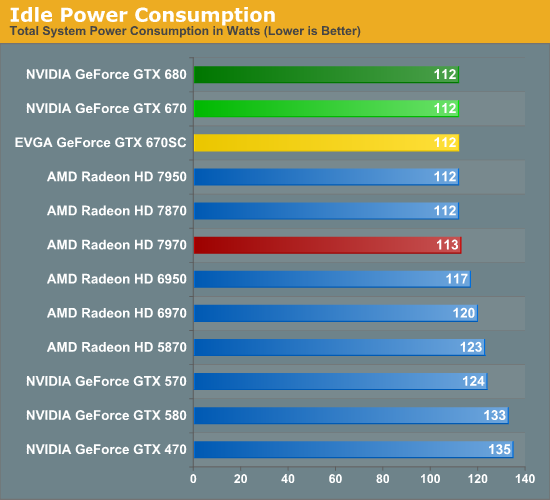
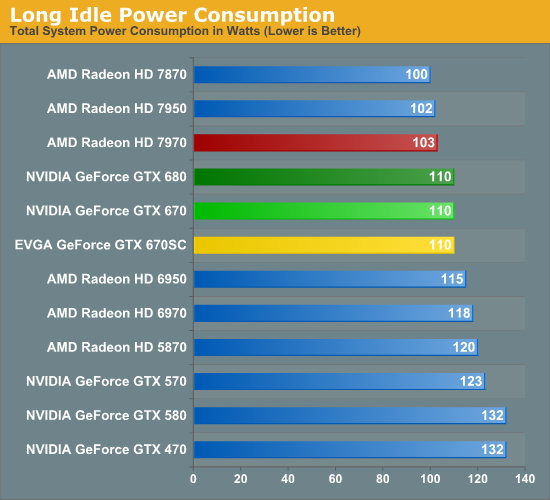
Starting with idle power, there aren’t any major surprised compared to the GTX 680. NVIDIA and AMD have both done such a good job managing their idle power consumption that even with the disabled SMX there’s no measurable difference between video cards. GTX 680 and GTX 670 effectively have the same idle and long idle power consumption.
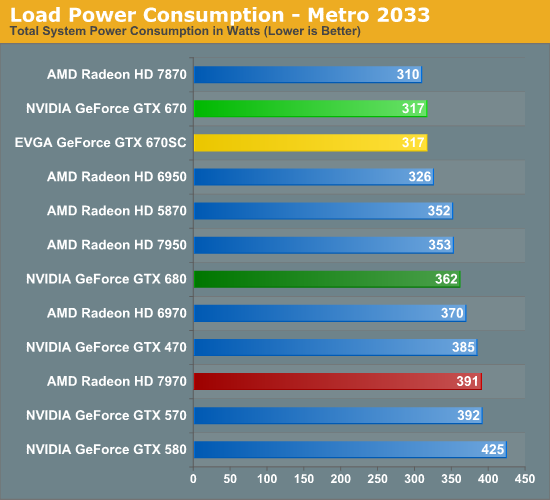
Moving on to load power consumption we can immediately see the GTX 670’s lower power target come into play. At 317W from the wall it’s 45W less than the GTX 680 for roughly 90% of the gaming performance, and this is in fact is lower power consumption than anything except the Radeon HD 7870. Even the GTX 560 Ti (which isn’t in this chart) is higher at 333W, reflecting the fact that GK104 is the true successor to GF114, and which would make GTX 670 the successor to GTX 560 from a design perspective.
Of course this also means that GTX 670 does very well for itself compared to AMD’s cards. We saw GTX 670 slightly outperform 7950 in Metro and here we see it drawing 36W less at the wall at the same time. Or compared to the 7970, 7970 can outperform GTX 670 by about 10%, but we’re drawing 74W more at the wall as a result.
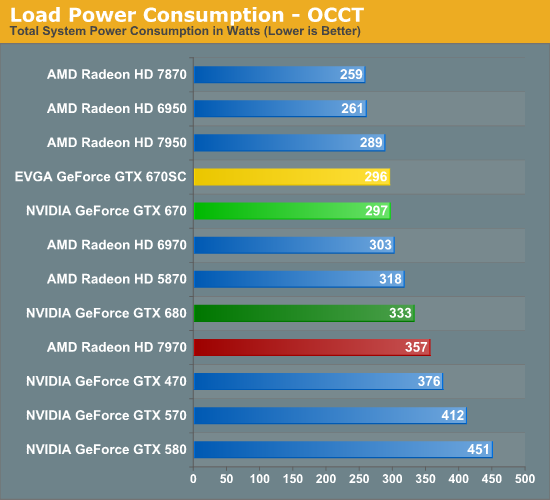
Relative power consumption shifts slightly under OCCT, but the story is otherwise similar. It’s not immediately clear why GTX 670’s power consumption is slightly higher than 7950 even after what we saw with Metro (PowerTune should be capping at 200W), but at least in this test the GTX 670 does end up doing a bit worse. On the other hand it’s still 60W less than the 7970.
Otherwise if we compare the GTX 670 to the GTX 680 we see that the GTX 680 ends up drawing 36W more at the wall, only a bit less than the difference we saw under Metro and quite close to what we’d expect based on the cards’ specifications.
On a related note, pay close attention to NVIDIA’s power target system in action here. In spite of the fact that the GTX 670SC is a binned part running at a lower voltage and higher clockspeeds, it’s drawing 1W less than the reference GTX 670. It would appear that NVIDIA has very good control over their power consumption overall, even if they can only adjust clocks for it a few times per second.
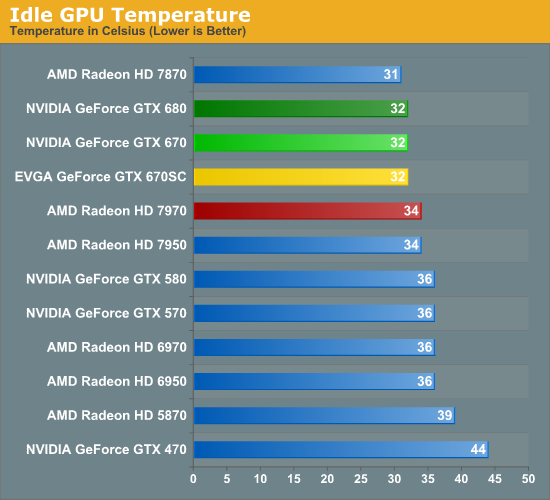
Seeing as how NVIDIA is using roughly the same cooler design with GTX 670 as they are with GTX 680 and they have the same idle power consumption, it should come as no surprise that temperatures are so similar. 32C is among the lowest of the temperatures we’ll see for a blower unless it’s running fast & loud.
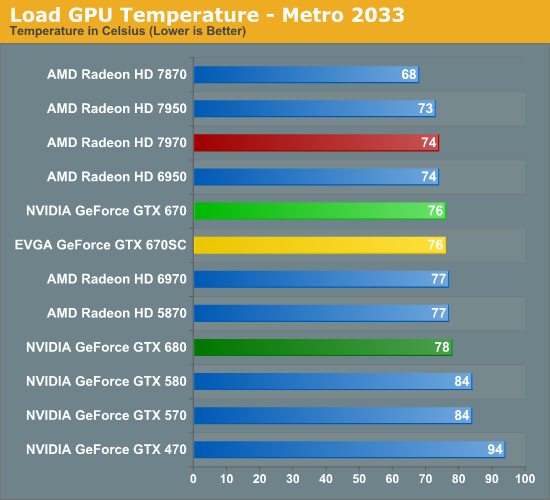
Thanks to the lower power consumption of the GTX 670 temperatures have gone down as well. 76C is still 2C warmer than the Radeon HD 7900 series due to AMD’s more aggressive cooler but it’s 2C cooler than the GTX 680. The thermal threshold for GK104 is 98C, which means there’s still over 20C of thermal headroom to play with here.

OCCT pushes temperatures up some, but not by much thanks to NVIDIA’s power target system. Since the GTX 680 tied the 7970 at 79C here, this means the GTX 670 is 2-3C cooler than both the GTX 680 and the 7970, and 0-1C warmer than the 7950.
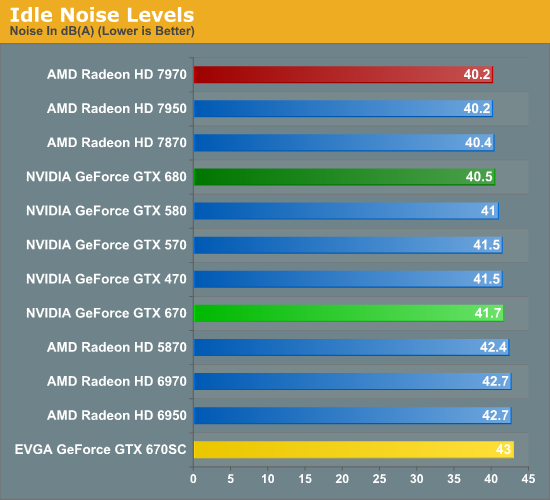
Unfortunately the impressiveness of the GTX 670 begins to wane some here at noise. NVIDIA tells us that the GTX 670 uses the same fan as the GTX 680 but this seems questionable. 41.7dB is not significantly louder than the GTX 680’s 40.5dB, but there’s a definite difference in pitch compared to the GTX 680. The GTX 670 seems to have a low pitch hum/grind to it that GTX 680 didn’t have.
Meanwhile EVGA’s card fares the worst here, at the precipice of falling out of the quiet zone. Since it’s using what’s fundamentally the same fan and cooler as the reference card, the only practical explanation is that EVGA’s smaller diameter fan intake has a negative impact on fan noise.
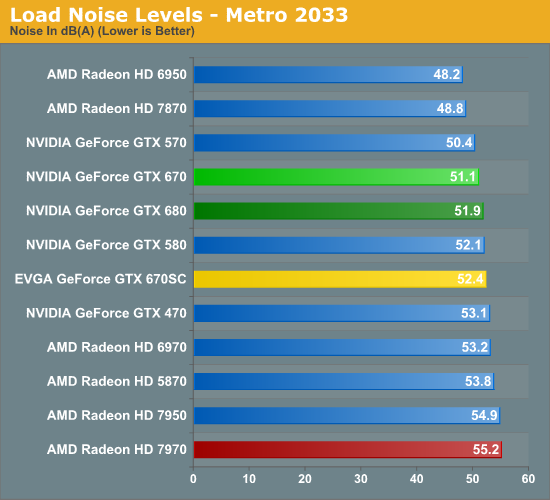
Finally, when looking at load noise we see that the GTX 670 doesn’t fare significantly better or worse than the GTX 680 here. At 0.8dB quieter than the GTX 680 the GTX 670 is a smidge quieter, but it’s nothing that’s particularly appreciable. Perhaps the more important fact is that this is 3.8dB quieter than the 7950 and 4.1dB quieter than the 7970, making the GTX 670 notable quieter than either 7900 series card. In practice the only place the GTX 670 loses is oddly enough to the GTX 570. The GTX 570 was 0.7dB quieter than the GTX 670 despite the former’s much higher power consumption. NVIDIA did let the GTX 570 get hotter than the GTX 670 so it looks like the GTX 670’s fan curve is a bit more aggressive than the GTX 570’s.
As for the EVGA GTX 670 Superclocked we’re seeing the same thing that we saw at idle: it’s just a bit louder than the reference GTX 670. This is in spite of the fact that the GTX 670SC’s fan actually went to the same speed as the reference GTX 670’s fan in this test.
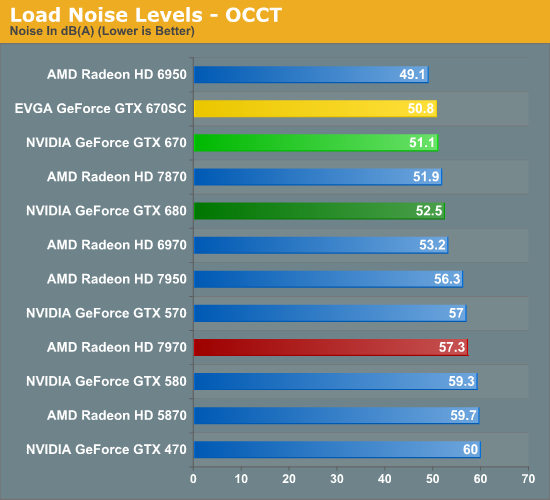
NVIDIA’s power target once more makes itself known here, thanks to which power consumption and thereby heat generation increases very little compared to what we saw under Metro. This widens the gap between the GTX 670 and 7900 series, which is now at 5.2dB and 6.2dB compared to the 7950 and 7970 respectively. Or compared to NVIDIA cards this is 1.4dB quieter than the GTX 680 and nearly 6dB quieter than the unthrottled GTX 570.
Meanwhile there’s something very interesting going on with the GTX 670SC that’s a wider reflection of the GTX 670’s reference fan. The fan speed went up but objective noise (A-weighted) went down. Why? That low-pitch hum we mentioned diminishes with a higher fan speed, and as a result the fan gets quieter once it passes a certain threshold. Subjectively we agree with our sound meter: the GTX 670SC sounds quieter here than it does as the lower fan speed it uses for cooling during Metro. We haven’t experienced anything like this with the GTX 680, which makes us further doubt that the fans are identical between the GTX 680 and GTX 670. Close no doubt, but not the same.
Wrapping things up this entire scenario is very similar to how we saw the launch of the GTX 680 play out. NVIDIA has a strong performing part with less noise and less power consumption than either its 500 series predecessors or AMD’s closest competition. This in turn was a big part of what made the GTX 680 so easy to recommend, as better performance with less noise is exactly the kind of direction we like to see video cards move in.










414 Comments
View All Comments
Spunjji - Friday, May 11, 2012 - link
Thank you for being a voice of sanity in an otherwise brutally argumentative and deeply sad comments section. +1 to you.CeriseCogburn - Friday, May 11, 2012 - link
"Voice of sanity" your amd fanboy friend, got the 43% larger amd wafer die size "cost drop not a problem" a bit overlooked, not to mention the 3 added free games additional cost.Is it a voice of reason to claim the largest base cost of the card at 43% greater is no problem since the "dies" are "about the same size" ?
ROFL... tsk tsk.
SlyNine - Saturday, May 12, 2012 - link
Its 43% greater now.Also you seem to forget the 7970 wins in 5 out of 10 of Anandtechs benchmarks.
Since you're going to argue this with me I'll put it out right now.
Crysis AMD
Metro AMD
Dirt 3 ( on the MOST Intensive test 5760x1200 min frames) Tied, but to me min frames is more important so I'd rather have AMD in that situation.
Now you can argue , But NVidia wins on the other res's But since this is the ONLY time it even gets below 60 this is the ONLY test that it really makes a difference.
ShoGun, AMD, big time, ya nvidia wins when FPS is over 100, but AMD wins by a lot when FPS is at a premium. With a driver fix I'm sure it will be a lot closer.
Batman, Basically a tie, yea Nvidia takes it but C'mon, 1 fps when it matters most. My guess is if they added 4x aa to the 3 screen mode AMD would take it.
Portal 2 Nvidia kills AMD, esp. in the high res, because that's where fps are low enough that the diff matters.
Battlefield 3 Nvidia kills amd again. and again when FPS matters.
SC2, Nvidia is faster. FPS is so high it doesn't matter But AMD is catching up fast and with the 5760res I wonder if AMD wouldn't' win. and by then FPS might actually matter.
Skyrim, same as SC2, AMD is catching up fast at the higher resolution, if it keeps going AMD might come out ahead where FPS is low enough that the difference matters.
Civ 5, tie. With the trend the Nvidia might be better at higher res here.
Portal 2 and BF3 are the to situation in Anands testing suit where Nvidia is MUCH better.
But other than that FPS either doesn't matter or AMD is winning when FPS is low enough that the difference matters.
As far as future games, we have NO idea what card might be better, but AMD does seem to have more raw power, and has more ram.
In compute AMD won 2 , loses one by like 7% and then actually loses one by a lot. Of course it doesn't have a cuda score so how to you count that as a loss, that's stupid.
CeriseCogburn - Sunday, May 13, 2012 - link
You make excuses across the board for the amd card, and nVidia's card is a smoother experience anyway if you want to glom onto min frames - and we haven't even used things like adaptive v-sync (better min frame rates for nVidia), nor did you figure in the enormous drivers difference.It's just such a huge gap when everything is considered it's beyond ridiculous to go for the amd card, as this amd favoring reviewer even admits.
Have your favorite brand, but you've got stretch and spin to justify it.
Galidou - Sunday, May 13, 2012 - link
I could just really stop answering you if that wasn't for the fact you're being so much disrespectful. I have a little problem with people lacking of respect, I have to let them know they are, even more when they do not think they are lacking respect...CeriseCogburn - Sunday, May 13, 2012 - link
You have never answered anything late comer troll Galidou, you're a pure 100% trolling personal attacker right now fella in all your posts so far. You have said absolutely nothing, so it is clear you should have never posted.Galidou - Monday, May 14, 2012 - link
I'm not attacking your person, just the way you throw your arguments at people calling them names like they are pure ignorant worthless living zombies... it just feels that way...Gastec - Tuesday, November 13, 2012 - link
"You make excuses across the board for the amd card, and nVidia's card is a smoother experience[..] - and we haven't even used things like..."We? WE?? YOU are from NVIDIA???? And you post here and admit it? I think you can get fired for doing this.
Or maybe you are not from nVidia but because you use a nVidia card you, for some very disturbing reason, feel like you are part of the company?
CeriseCogburn - Friday, May 11, 2012 - link
Okay, first of all substantial competition is the GTX590 and the 6990, that both still beat the overpriced amd lost 3 and only won 2 compute benchmarks in that 2.5+ month evil amd price scalping period before the massive smack down the nVidia 680 delivered.Now nVidia made a third move, the 670, not the initial move as you spoke about it, and this third move is another massive smackdown on the already smacked down by the 680 failing and utterly depleted value 7970 has to endure.
Nice try pretending the 1st smack down just occurred, but once again, what else to expect from an amd fanboy, and also clearly why another amd fanboy immediately thanked you a perfectly leveled headed post. LOL
Now onto your other ridiculous spew, based on facts not twisted perceptions.
You note the die sizes of the competing products, and conclude by stupid first look there is no reason amd cannot drop it's price (again) - you avoid the again, twice - (once for $$$(yes 3 figures), twice for 3 games added, now a 3rd time coming ) - but whatever, let's take your die size non chalant info and do our little math amd fanboys now desperately want to avoid.
300mm sq. nVidia vs 365mm sq Amd - doesn't look so bad does it ?
Unfortunately, the Amd die is well over 40% LARGER :)
Sorry about that amd fanboy brainfart .... you forgot to multiply for AREA, hence size/cost of the wafer....
300x300 vs 365x365
90,000 nVidia wafer area vs 133,225 huge 43% + more amd wafer cost.
So let's get this straight - do you still not really see a problem ?
yankeeDDL > " AMD will need to drop the prices and I see really no reason why they couldn't, as they have just a marginally larger die size (300mm2 vs 365mm2) on the same fab/technology. "
So 43% plus more base cost, no problem going a hundred bucks + games costs less... ?
R O F L
Thank you, as the amd fanboy said, for being such a clear thinking person with a calm and fair mind... (rolls eyes)
SlyNine - Saturday, May 12, 2012 - link
Its hard to say the 680 was a smack down when most people couldn't even get the card..You seem to be angered by the 7970. I agree that it was not a good deal. But its not a bad card either.